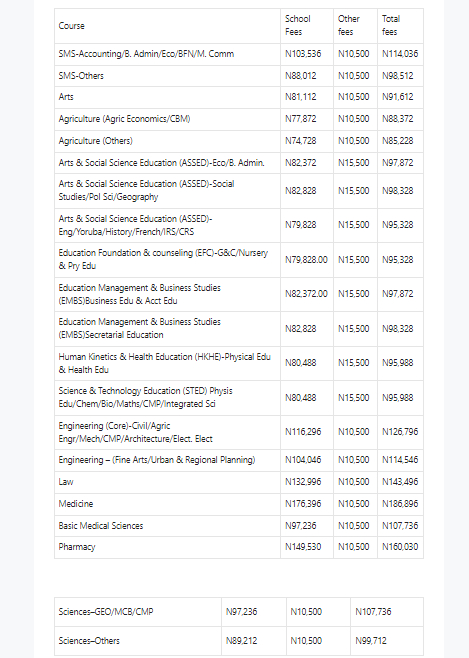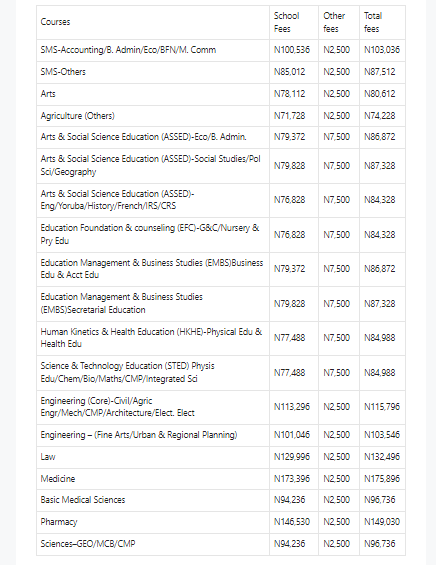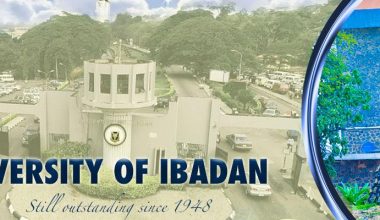Before applying to a university in Nigeria, you must find out all that is required of you. So, if you’re considering applying to Olabisi Onabanjo University (OOU) for the 2025 academic year, you must wonder what the OOU aggregate cut off mark for all courses is.
The cut-off mark is not the only thing to look out for; you should also find out what the cut-off mark for your desired course is, as well as the admission requirements and fees.
In this article, we will discuss all these things and answer most of the questions you may have about this University.
Table of contents
- Olabisi Onabanjo University
- Is OOU a federal or state university?
- What rank is Olabisi Onabanjo University?
- How much are Olabisi Onabanjo school fees?
- OOU school fees as a returning student
- How much are OOU acceptance fees?
- Does OOU do post UTME exams?
- Does Olabisi Onabanjo University accept second choice?
- What is OOU cut off mark?
- OOU aggregate cut off mark for all courses
- OOU department cut off mark
- How to calculate OOU cut off mark
- Is OOU offering nursing?
- Is there a pharmacy course in OOU?
- What are the medical courses offered in OOU?
- FAQs
- Conclusion
- References
- Recommendations
Olabisi Onabanjo University
Olabisi Onabanjo University is one of the very popular universities in Nigeria. It is located Ago-Iwoye, Ogun State, Nigeria. Founded in 1982 and has since grown to become one of the top universities offering some of the country’s best undergraduate and graduate courses.
The university is known for its big and beautiful campus, dedicated faculties, and modern facilities and students from all over the country come here to study.
Aside from academics, OOU also offers many extracurricular activities, organizations, and clubs for students to get involved in away from classes. Whether you are interested in sports, art, politics, or culture, there’s an organization or club for everyone.
Also, this university is rich in history and tradition has a strong alumni network, and has produced some successful and notable graduates in different fields.
Read: Nnamdi Azikiwe University Cut Off Mark For All Courses | 2024
Is OOU a federal or state university?
OOU is a state university. This means that it is owned and operated by the Ogun State government, and not an individual or the federal government of Nigeria.
While federal universities are known to be larger and have more resources for academics, state universities are known to have a more intimate learning environment and a strong connection to the local community.
What rank is Olabisi Onabanjo University?
According to recent data, OOU is ranked among the top 8,091 institutions in the world and among the top 300 in Africa, which is impressive. This ranking is based on factors like academic quality, international reputation, and research output.
Although knowing a university’s ranking is important when considering which to choose from, you must understand that rankings are not the only things that matter.
When choosing, you should also consider things like the university’s acceptance rate, programs, resources, and offerings to make sure it’s a good fit for you.
How much are Olabisi Onabanjo school fees?
Olabisi Onabanjo school fees may differ depending on if you are a new student or a returning student and on your department. We will give you a breakdown of the fees for new students and returning students below:
OOU school fees for freshers
Here’s all you need to know about fees at OOU as a fresher:

OOU school fees as a returning student
Here’s all you need to know about fees at OOU as a returning student:

Also, read: Kogi State University cut-off mark for all courses | 2024/2025 Admission Requirements and Fees
How much are OOU acceptance fees?
The OOU acceptance fee is 75,000 Naira.
If you’ve been accepted to Olabisi Onabanjo University (OOU), you must pay a non-refundable acceptance fee of 75,000 Naira.
This fee is your way of securing your spot in the school. It helps to cover some of the costs around your admission, such as preparing for your arrival at the university and processing your paperwork.
Does OOU do post UTME exams?
Yes, OOU does conduct a Post-UTME (PUTME) Screening for prospective students. This screening helps the university assess your academic readiness for university-level studies and determine whether you’re a good fit for their programs, or the course you have applied for.
If you are applying for the 2025 academic year, know that OOU has yet to announce the date for their post-UTME screening, otherwise known as Aptitude Test, for this coming academic year. However, it is likely to commence in September 2024. Be sure to watch our website for an update on that.
Does Olabisi Onabanjo University accept second choice?
No, OOU does not usually accept candidates who put them as their second choice. If you’re applying to OOU, you should list it as your first choice on the JAMB form.
What is OOU cut off mark?
The OOU aggregate cut off mark, which is also the general cut off mark for universities in the country, is 180. If you score at least 180 on the JAMB UTME computer-based test, you’ve met the minimum requirement for admission to Olabisi Onabanjo University.
Well, while this is the case, you must know that this is the general cut-off mark for all universities in Nigeria. Some universities may have a higher or lower cut-off mark for specific courses.
That aside, the university you choose may likely have different cut off marks for each department which will be higher than the cut off mark.
So, your best bet may not just be to score the cutoff mark but also to score higher to stand a better chance of getting into the university, as scoring 180 is just proof of eligibility and not a guarantee of admission.
OOU aggregate cut off mark for all courses
The OOU aggregate cut-off mark for all courses is 180, which also doubles as the JAMB general cut-off mark for universities in the country.
If you score 160 or above on the JAMB UTME computer-based test, you’re eligible for admission to Olabisi Onabanjo University. Below is a list of OOU courses:
- Accounting
- Agric-Extension and Rural Sociology
- Agricultural Economics & Farm Management
- Agricultural Engineering
- Agriculture
- Anatomy
- Applied Zoology
- Banking and Finance
- Biochemistry
- Business Administration
- Business Education
- Chemical Sciences
- Chemistry
- Christian Religious Studies
- Civil Engineering
- Civil Law
- Computer Engineering: Computer Science
- Crop Production
- Economics
- Education Accounting
- Education and Biology
- Education and Chemistry
- Education and Computer Science
- Education and Economics
- Education and English Language
- Education and French
- Education and Geography
- Education and Integrated Science
- Education and Mathematics
- Education and Physics
- Education and Political Science
- Education and Social Studies
- Education and Yoruba
- Electrical/Electronics Engineering
- English Language
- Fine and Applied Arts
- Fisheries
- Forestry and Wildlife
- Forestry, Wildlife and Fisheries
- French
- Geography and Regional Planning
- Geology
- Guidance and Counselling
- Health Education
- History and Diplomatic Studies
- Home and Hotel Management
- Home Economics
- Industrial and Labour Relations
- Industrial Chemistry
- Islamic Studies
- Linguistics
- Mass Communication
- Mathematics
- Mechanical Engineering
- Medicine and Surgery
- Microbiology
- Music
- Nursery and Primary Education
- Nursing/Nursing Science
- Performing Arts
- Pharmacology
- Pharmacy
- Philosophy
- Physics
- Physiology
- Plant Science
- Political Science
- Psychology
- Public Administration
- Secretarial Administration
- Sociology
- Sport Science
- Statistics
- Teacher Education Science
- Transport Planning and Management
- Urban and Regional Planning
- Yoruba
See Also: List of courses offered in Ekiti State University and their cut off mark | 2024
OOU department cut off mark
Here’s the cut off mark for each department/ OOU cut off mark for all courses:
- Accounting – 230
- Agricultural Economics and Farm Management – 180
- Agricultural Engineering – 210
- Agricultural Extension and Rural Sociology – 180
- Agriculture – 180
- Agriculture Cooperative Management – 180
- Anatomy – 190
- Applied Zoology – 180
- Banking and Finance – 200
- Biochemistry – 200
- Business Administration – 180
- Business Education – 180
- Chemical Sciences – 180
- Chemistry – 180
- Christian Religious Knowledge / Studies – 180
- Civil Engineering – 220
- Civil Law – 220
- Computer Engineering – 220
- Computer Science – 200
- Crop Production – 180
- Economics – 190
- Education Accounting – 180
- Education and Biology – 180
- Education and Business Administration – 180
- Education and Chemistry – 180
- Education and Computer Science – 180
- Education and Economics – 180
- Education and English Language – 180
- Education and French – 180
- Education and Geography – 180
- Education and Geography / Physics – 180
- Education and Integrated Science – 180
- Education and Mathematics – 180
- Education and Physics – 180
- Education and Political Science – 180
- Education and Social Studies – 180
- Education and Yoruba – 180
- Electrical / Electronic Engineering – 230
- English Language – 200
- Fine / Applied Art – 180
- Fisheries – 180
- Forestry And WildLife – 180
- Forestry Wildlife And Fisheries – 180
- French – 180
- Geography and Regional Planning – 180
- Geology – 180
- Geology / Regional Planning – 180
- Guidance and Counseling – 180
- Health Education – 180
- History and Diplomatic Studies – 180
- Home And Hotel Management – 180
- Home Economics – 180
- Industrial And Labour Relations – 180
- Industrial Chemistry – 200
- Islamic Studies – 180
- Linguistics – 200
- Mass Communication – 230
- Mathematics – 180
- Mechanical Engineering – 220
- Medicine and Surgery – 270
- Microbiology – 190
- Music – 180
- Nursery and Primary Education – 180
- Nursing / Nursing Science – 250
- Performing Arts – 180
- Pharmacology – 200
- Pharmacy – 260
- Philosophy – 180
- Physics – 180
- Physiology – 180
- Plant Science – 180
- Political Science – 210
- Psychology – 180
- Public Administration – 180
- Secretarial Administration – 180
- Sociology – 180
- Sport Science – 180
- Statistics – 190
- Teacher Education Science – 180
- Transport Planning and Management – 180
- Urban and Regional Planning – 180
- Yoruba – 180
- Christian Religious Studies (CRS) – 180
- Fine and Applied Arts – 180
How to calculate OOU cut off mark
Okay, let’s go through calculating your OOU aggregate score together. First, you’ll need your JAMB score, post-UTME score, and O’ level results. Then, you’ll use these three scores to calculate your overall aggregate score.
Here’s how to do it:
- JAMB Score: Divide your JAMB score by 8 to make it 50% of your total score.
- O’ Level Results: Count the points for each of your five best O’ level subjects, with different points for each grade.
- Post UTME Score: Multiply your Post UTME score by 0.3 (30%) to get its portion of the aggregate score.
- Total Score: Add up the JAMB, O’level, and Post UTME scores to get your total aggregate score.
Now, let’s use an example to make this process more transparent. Say a student scores 202 in JAMB, grades B3, C5, C4, B2, and C6 in his/her O’level subjects, and gets 58% in Post UTME.
To calculate the student’s aggregate score, we’ll divide the JAMB score by 8 to make it 50% of the total score.
JAMB Score: 202 / 8 = 25.25
Then, we’ll multiply the O’level score by 2/3 to make it 20% of the total score.
O’level Result: 4 + 2 + 3 + 5 + 1 = 15
15 x 2/3 = 10
Finally, we’ll multiply the Post UTME score by 0.3 (30%) to get its portion of the total score.
Now, we add up the JAMB score, O’level score, and Post UTME score to get the total aggregate score:
Total Score = 25.25 (JAMB) + 10 (O’level) + 17.4 (Post UTME) = 52.65
So, in this example, the student’s composite score is 52.65.
Is OOU offering nursing?
Yes, Olabisi Onabanjo University (OOU) offers a full-time Bachelor of Nursing Science (B.NSc.) program. The National Universities Commission (NUC) approved the program in 2018.
If you’re interested in pursuing a career in nursing, OOU could be a great option for you.
See Also: Is a Nursing Degree Hard? | 2024 Expert Tips
What is the OOU cut off mark for nursing?
The OOU cut off mark for the Nursing Science is 250. If you want to be considered for admission into the program, you’ll need to score at least 250 in your JAMB UTME exam.
This cut off mark may seem high, but that’s because nursing is a highly competitive program at OOU. But don’t let that discourage you. If you put in the hard work and dedication, you can undoubtedly score higher in the UTME and have a chance at securing a spot in the university in that department.
Is there a pharmacy course in OOU?
Yes, Olabisi Onabanjo University (OOU) does offer a pharmacy course. If you’re interested in studying pharmacy at OOU, you must meet the university’s cut off mark of 260 in your JAMB UTME exam.
Pharmacy is another highly competitive program at OOU. The high cut-off mark reflects the university’s desire to attract only the most qualified and committed students to the program.
What are the medical courses offered in OOU?
Here’s a list of the medical courses at OOU:
- Anatomy
- Applied Zoology
- Biochemistry
- Nursing / Nursing Science
- Pharmacy
- Pharmacology
- Physiology
- Microbiology
- Medicine and Surgery
Read Also: Official List of Medical Courses in Nigeria | Relevance, Requirements, and Schools
FAQs
Yes, OOU is under ASUU and is part of the Lagos Zone of ASUU.
Olabisi Onabanjo University (OOU) is owned and managed by the Lagos State Government. It was named after the former Governor of Ogun State, Olabisi Onabanjo.
Olabisi Onabanjo University (OOU) is a public university.
Conclusion
OOU, like all other universities in Nigeria, has specific cut off marks for each of its courses that prospective students need to meet to be eligible for admission.
Although the general cut-off mark for OOU and other universities in the country is 180, some courses have higher cut-off marks. So, you must understand these cut off marks and how to calculate them to know what to expect.
References
- blog.edukoya.com – OOU Cut-Off Mark Is Out
- tertiarynaija.com.ng – OOU Departmental Cut Off Mark For All Courses
- backtoschool.com.ng – OOU School Fees for all Courses






